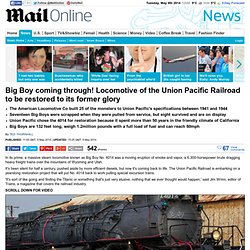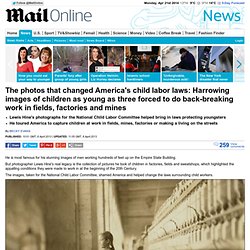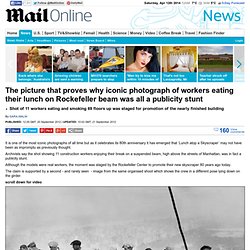

Big Boy coming through! Locomotive of the Union Pacific Railroad to be restored to its former glory. The American Locomotive Co built 25 of the monsters to Union Pacific's specifications between 1941 and 1944Seventeen Big Boys were scrapped when they were pulled from service, but eight survived and are on display Union Pacific chose the 4014 for restoration because it spent more than 50 years in the friendly climate of CaliforniaBig Boys are 132 feet long, weigh 1.2million pounds with a full load of fuel and can reach 80mph By Ted Thornhill Published: 11:05 GMT, 5 May 2014 | Updated: 15:25 GMT, 5 May 2014 In its prime, a massive steam locomotive known as Big Boy No. 4014 was a moving eruption of smoke and vapor, a 6,300-horsepower brute dragging heavy freight trains over the mountains of Wyoming and Utah.

It's been silent for half a century, pushed aside by more efficient diesels, but now it's coming back to life. The Union Pacific Railroad is embarking on a yearslong restoration project that will put No. 4014 back to work pulling special excursion trains. Even the name is legendary. Lewis Hine: Harrowing images of child labourers that show children as young as three forced to do back-breaking work in fields, factories and mines. Lewis Hine's photographs for the National Child Labor Committee helped bring in laws protecting youngsters He toured America to capture children at work in fields, mines, factories or making a living on the streets By Becky Evans Published: 10:01 GMT, 8 April 2013 | Updated: 11:05 GMT, 8 April 2013 He is most famous for his stunning images of men working hundreds of feet up on the Empire State Building.

But photographer Lewis Hine's real legacy is the collection of pictures he took of children in factories, fields and sweatshops, which highlighted the appalling conditions they were made to work in at the beginning of the 20th Century. The images, taken for the National Child Labor Committee, shamed America and helped change the laws surrounding child workers. A 11-year-old young girl gazes out of the window during a break from her factory work in Lincolnton, North Carolina. Amos, six, (right) and Horace, four, are dwarfed by the tobacco plants they tend in this picture from 1916. The haunting images of workers as young as EIGHT in Massachusetts mill that helped change child labor laws. By Daily Mail Reporter Published: 19:28 GMT, 27 September 2012 | Updated: 19:33 GMT, 27 September 2012 Youngsters today may lie about their ages to sneak into movies or bars, but a century ago, the fibbing stakes were considerably higher - as children routinely lied to keep their families above the poverty line.

Haunting images taken at mills in Winchendon, Massachusetts in 1911 capture the faces of children as young as eight as they illegally endured unsafe conditions, long hours and poor pay to keep their families from starving. In a sad twist, the workers spent their hours making wooden toys - from doll furniture, drums and building blocks - for other youngsters who did not have to spend their childhood and adolescence cooped up inside the mills' four walls.
While children under the age of 12 were not legally allowed to work in the mills, Hine noted that many appeared much younger, while others claimed they were older in order to be able to work longer hours. President Franklin D. The picture that proves why iconic photograph of workers eating their lunch on Rockefeller beam was all a publicity stunt. Shot of 11 workers eating and smoking 69 floors up was staged for promotion of the nearly finished building By Sara Malm Published: 12:29 GMT, 20 September 2012 | Updated: 10:43 GMT, 21 September 2012 It is one of the most iconic photographs of all time but as it celebrates its 80th anniversary it has emerged that ‘Lunch atop a Skyscraper’ may not have been as impromptu as previously thought.

Archivists say the shot showing 11 construction workers enjoying their break on a suspended beam, high above the streets of Manhattan, was in fact a publicity stunt. Although the models were real workers, the moment was staged by the Rockefeller Center to promote their new skyscraper 80 years ago today. The claim is supported by a second - and rarely seen - image from the same organised shoot which shows the crew in a different pose lying down on the girder. scroll down for video ‘The image was a publicity effort by the Rockefeller Center. The building began in May 1930 and took nine years to complete. Children in street work : McGill, Nettie Pauline.